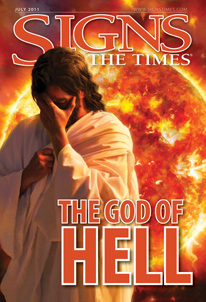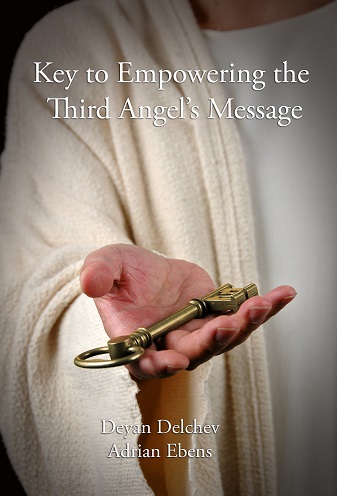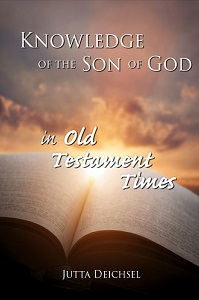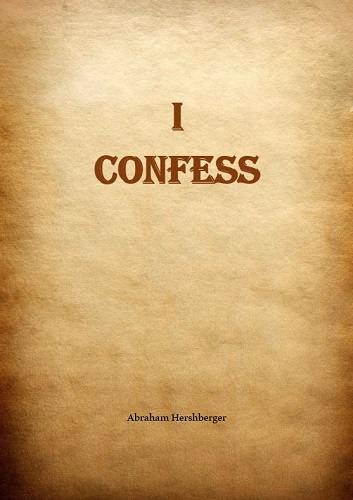Do We Worship That Which We Know Not?
Do We Worship That Which We Know Not?
compiled by Frank Klin
“While Christians and Jews agree that there is only one God,
Christians see a picture of Three. ”
(Seth Pierce, The Trinity- Unconfusing the Confusing, Signs of the Times, July 2011)

Photo Source: rdegrie—istockphoto.com
(My personal comments are in blue text)
Members of the Seventh-Day Adventist Church, we are called to be a witness of the Gospel to the world. If you wanted to give a reason for your faith by telling someone about the “God” you worship would you be careful that the picture you painted with your words was reverent and respectful? What illustration could you find that portrayed the majesty awe, honour and praise in your heart?
The July 2011 issue of the SDA publication Signs of the Times wanted to help you tell the world about the God you worship. When you turn to the article on the trinity by Seth Pierce you are greeted with the above caricature. Why? Could the reason for this be because it is de rigueur to point out that God, as represented by the trinity, is an unfathomable mystery?
In the same issue of the “Signs” there is a Bible Discovery study on the trinity by Errol Webster. He conveniently sidesteps Scripture to endorse manmade ideas, theories and philosophies. These are intended to explain the Scripture.
We are going to present excerpts from the two “Signs” articles and allow others a testimony to help us see what the consequences might be for presenting God in this way. If our main focus of who we worship is the mysteriousness of three co-equal, co-eternal Beings, what do the implications say about our own identity?
As jarring as the picture above may be to the senses and sensibilities, it is not without merit. Think about this. Would the gentleman in the photo be able to see a different view of God simply by removing his spectacles?
Before we look at the modern Signs of the Times read something notable in the very first issue of the same periodical published on June 4, 1874. Elder James White is listed as Editor and Proprietor. On page three is an introduction to 25 Fundamental Principles of faith held by the Seventh-day Adventist church:
“In presenting to the public this synopsis of our faith, we wish to have it distinctly understood that we have no articles of faith, creed, or discipline, aside from the Bible.”
“We do not put forth this as having any authority with our people, nor is it designed to secure uniformity among them, as a system of faith, but is a brief statement of what is, and has been, with great unanimity, held by them.”
Then followed the first two Fundamental Principles, held “with great unanimity” by the Adventist people of 1874.
- That there is one God, a personal, spiritual being, the creator of all things, omnipotent, omniscient, and eternal, infinite in wisdom, holiness, justice, goodness, truth, and mercy; unchangeable, and everywhere present by his representative, the Holy Spirit. Ps. 139:7.
- That there is one Lord Jesus Christ, the Son of the Eternal Father, the one by whom God created all things, and by whom they do consist; that he took on him the nature of the seed of Abraham for the redemption of our fallen race;…
These two statements remained virtually unchanged until 1931, and then in 1980 a new view of God was officially voted in as a Fundamental Principle of the Adventist church. After reading the current definition below see if you can tell the difference between the 1874 and ask yourself why the 1980 version is declared “Confusing” in Signs of the Times.
Trinity: There is one God: Father, Son, and Holy Spirit, a unity of three co-eternal Persons. God is immortal, all-powerful, all-knowing, above all, and ever present. He is infinite and beyond human comprehension, yet known through His self-revelation. He is forever worthy of worship, adoration, and service by the whole creation.
Now let’s discover how the modern Signs of the Times attempted to unconfuse the confusing. When you see the #s 1 or 2 after a quote they come from the July 2011 Signs articles on the trinity. All other numbers are identified at the end of this paper. This was prepared with love and respect in the hopes of facilitating prayerful Scripture study and soul searching.
“one or three?” [1]
“things become a little difficult” [1]
“In Christianity, there is … a picture of God that is difficult to make sense of. Religious scholars have fought about it and labeled each other heretics in the process of trying to unravel its composition and how it works.” [1]
“When it comes to the Godhead, there are … mysteries that we can’t understand.” [2]
“The picture begins with something called the Shema, a morning and evening prayer in Judaism. It’s a declaration: “Hear, O Israel: The Lord our God, the Lord is one” (Deuteronomy 6:4). The verse affirms that the God in the Bible is not many gods but one God. Both Jews and Christians are monotheistic, but as we look closer, things become a little difficult. Instead of one Divine Being in the Bible, Christians are presented with what appears to be Three.” [1]
“Tertullian” [2]
“The term Trinity, while not occurring in the Bible, is biblical. It was first used by Tertullian (about A.D. 190),” [2]
“Tertullian has the true formula for the Holy Trinity, tres Personae, una Substantia. The Father, Son, and Holy Ghost are numerically distinct, and each is God; they are of one substance, one state, and one power. So far the doctrine is accurately Nicene. But by the side of this appears the Greek view which was one day to develop into Arianism: that the unity is to be sought not in the Essence but in the origin of the Persons. He says that from all eternity there was reason (ratio) in God, and in reason the Word (Sermo), not distinct from God, but in vulva cordis. For the purpose of creation the Word received a perfect birth as Son. There was a time when there was no Son and no sin, when God was neither Father nor Judge. In his Christology Tertullian has had no Greek influence, and is purely Roman.” (Catholic Encyclopedia: Tertullian, newadvent.org)
“The ‘Schaff-Herzog Encyclopedia’ says that his writings [Tertullian] form the "foundation of Latin theology." That means that they form the foundation of Roman Catholic theology. This statement alone should make Protestants resolve to have nothing to do with him. For it is certain that no pure Christianity can be found in writings which form the foundation of Roman Catholicism… Surely such an author ought to be put into perpetual quarantine. If it had been done centuries ago, it would have saved Protestantism to a great extent from becoming tainted with his Roman Catholic contagion; for no Father has done more than he to establish the Roman Catholic Church. (E.J. Waggoner, “Fathers of the Catholic Church”, page 185, 189)
“Christianity Today” quotes Tertullian in an article touting the Harry Potter series of books and films:
“With sales of well over 400 million copies—dwarfing all published works not written by God or Chairman Mao—the Harry Potter series is the shared text of our time… This is a great thing. The love of these books and their characters confirms the power of traditional Christian literary arts to reach and stir the human heart. It also confirms Tertullian's remarkable observation that "all souls are Christian souls": that we all have darkened hearts that only Christ can illumine. (John Granger, “Harry Potter Is Here to Stay”, Christianity Today, July 2011)
“council of Nicaea” [2]
“The term Trinity, while not occuring in the Bible, is biblical. It was … endorsed at the Council of Nicaea (A.D. 325), to describe what the Bible says about God. There’s one Godhead of Three distinct Persons in unity.” [2]
“The Ecumenical Council of Nicea AD 325 was convened by Constantine in the face of the Arian controversy. Arius, a Libyan preacher, had declared that although Jesus Christ was divine, "there was when he was not.” This made Jesus less than the Father and contradicted the doctrine of the Trinity. The formulation of the Symbol of Faith…explicitly affirms the divinity of Jesus, applying to him the term "God". The 381 A.D. version speaks of the Holy Spirit as worshipped and glorified with the Father and the Son.” (“Nicene Creed” & “Coptic Orthodox Church”, wikipedia)
“Athanasius (Athanasios) took a prominent part against the Arians at the Council of Nicaea. From that time during his whole life he struggled for the doctrine of Christ's essential divinity and eternal coexistence with the Father, and his importance as a theologian is that he developed this idea. Five times he was sent into exile and five times returned to power by the swing of the pendulum-like church politics of the Eastern emperors, but he lived to see his idea conquer, and it is to-day an essential part of the Catholic creed.” (1907, “Library of Original Sources, Vol. 4”, edited by Oliver Joseph Thatcher, page 71-72. & “Source Book for Bible Students,” 1940 revised, Review & Herald Publishing Assoc., page 40)
Constantine
“I can’t remember when I first heard the name of the Roman emperor Constantine, but I'm sure it was in church and I'm sure I was very young. Along with most lifelong Seventh-day Adventists, I learned early on that Constantine was the "bad guy" in the big switch from Sabbath to Sunday, proclaiming the "Venerable Day of the Sun" as the day on which all should worship. Of course, Constantine didn't invent Sunday worship--he legitimized a practice the church had drifted into the past two centuries as it struggled to assimilate pagan converts and dissociate itself from Judaism. Still, for most Adventists Constantine's name is indissolubly linked with that fatal error.” (Trudy J. Morgan-Cole, “Constantine or Christ, Whom Will You Join?” Adventist Review October 16, 2003)
Along with most lifelong Seventh-day Adventists, I learned early on that Constantine was the "bad guy" in the big switch from Sabbath to Sunday. What I didn’t know is that he assembled the Council of Nicaea where the doctrine of the trinity was accepted as a fundamental belief and an agreement was reached on when to celebrate the feast of Easter, the “Christian” Passover. Of course, Constantine didn't invent Sunday sacredness, the feast of Easter, or the worship of God as a trinity--he legitimized beliefs and practices the church had drifted into as it struggled to assimilate pagan converts and dissociate itself from Judaism. Still, for most Adventists and other Christians the trinity is not listed as one of Contantine’s fatal errors. (Adapted by Frank Klin)
“what the Bible presents” [2]
“The term Trinity, while not occuring in the Bible, is biblical… We may not understand it, but this is what the Bible presents. [2]
“It is indeed true that the name "Trinity" is nowhere to be found in the Holy Scriptures, but has been conceived and invented by man.” (Martin Luther, “The Sermons of Martin Luther, Church Postil,” 1522; III:406-421, PC Study Bible formatted electronic database Copyright © 2003, 2006 by Biblesoft, Inc. All rights reserved.)
“If we read the Bible, we will encounter, right at the beginning, that one of the Hebrew names for God is YHWH (pronounced Yahweh). YHWH makes appearances throughout the Old Testament. In the New Testament, He is likened to a Father and so we see a Divine Being referred to as the Father, who resides in heaven and deserves glory.” [1]
“But the Bible also talks about a Being called Jesus, who is also described as God!” [1]
“In describing Jesus’ birth, the Gospel of John opens with, “In the beginning was the Word, and the Word was with God, and the Word was God” (John 1:1). In Greek, the term logos, translated in English as “Word,” carries the connotation of creative force, mental ability and reason. In this passage, the Word refers to a Divine Being with knowledge and power who was not only with God in the beginning of Creation but is Himself God” [1]
Notice the author did not point out that Jesus was the literal Son of God. Another mystery?
“It is impossible to believe explicitly in the mystery of Christ, without faith in the Trinity... Wherefore just as, before Christ, the mystery of Christ was believed explicitly by the learned, but implicitly and under a veil, so to speak, by the simple, so too was it with the mystery of the Trinity. And consequently, when once grace had been revealed, all were bound to explicit faith in the mystery of the Trinity.” (“The Summa Theologica of St. Thomas Aquinas, Second and Revised Edition”, 1920. Literally translated by Fathers of the English Dominican Province. Online Edition Copyright © 2003 by Kevin Knight, quoted on cogwriter.com)
“He [Jesus] has not always been the Son of God… His Sonship can only be figurative. Correspondingly, the Father has not always been the Father. These must have been adopted titles suitable for the parts the Two played in the Plan of Redemption.” (Max Hatton, “The Trinity Doctrine for Seventh-Day Adventists”) *See Tertullian above from the Catholic Encyclopedia.
“an ethereal Being?” [1]
“To add to the confusion, we also have a Third element to this “painting” of God. Known as the Holy Spirit or Spirit of God, this Being also appears to have been at work at Creation. Speaking of the world before it was formed into a habitable planet for humans and animals, Genesis 1:2 says, “Now the earth was formless and empty, darkness was over the surface of the deep, and the Spirit of God was hovering over the waters.” [1]
“In the New Testament, Jesus tells the disciples that even though He is ascending to heaven, He will “ask the Father, and he will give you another Counsellor to be with you forever—the Spirit of truth.” [1]
“In His prayer for the church Christ asks the Father to keep believers united to Him and to each other as He and the Father are united in the mystery of the trinity (John 17:21). The church participates in some way in the unity of the Godhead. Through the Spirit Christ established a union between Himself and believers that is as real as the union that exists between the different parts of our own bodies.” (Angel Manuel Rodriguez, Seventh-day Adventist Biblical Research Institute, “Ecclesiology and Reorganization: The Oneness of the Church”, 2006)
Do you see a problem with how the Scripture is used in the above quote? Please read the prayer of Jesus in John 17 and see if Jesus is truly asking His Father for believers to be united in the “mystery of the trinity.”
Ellen White spoke plainly, “If we draw nigh to God, individually, then don't you see what the result will be? Can't you see that we will draw nigh to one another? We cannot draw nigh to God, and come to the same cross, without our hearts being blended together in perfect unity, answering the prayer of Christ "that they may be one" as He is one with the Father. And therefore we should seek in spirit, in understanding, in faith, that we may be one, that God may be glorified in us as He is glorified in the Son; and that God shall love us as He loves the Son (MS 7, 1890). (SDA Bible Commentary Vol. 7, page 937 par. 8)
Sister White shed further light when she wrote the following to E.J. Waggoner and A.T. Jones, “Our Redeemer liveth to make intercession for us, and now if we will daily learn in the school of Christ, if we will cherish the lessons He will teach us in meekness and lowliness of heart, we shall have so large a measure of the Spirit of Jesus that self will not be interwoven into anything that we may do or say. The eye will be single to the glory of God. We need to make special efforts to answer the prayer of Christ that we may be one as He is one with the Father...” (1888 Materials page 29 par. 3)
Her words must be too simplistic because the church continues to weave the web of mystery.
re-examining “an ethereal Being?”
What is interesting to note is the thought about the Holy Spirit implanted with the question “an ethereal being?” That term is not to be found in Scripture and the question is never directly answered, so we will look more closely at what that term represents.
Ethereal: characterized by lightness and insubstantiality; intangible; lacking material substance; immaterial; bodiless; not of this world; spiritual.
Ethereal derives from the Latin aetherius, meaning “of or pertaining to the ether, the sky, or the air or upper air”, and from the Ancient Greek aitherios, meaning "of or pertaining to the upper air". Aether in Greek mythology is one of the Protogenoi, the first-born elemental gods. A deity, Aether is the personification of the upper sky, space, and heaven, and is the elemental god of the “Bright, Glowing, Upper Air”. (“Ethereal Being”, wikipedia)
This brings to mind Ephesians 2:2 where Satan is referred to as “the prince of the power of the air, the spirit that now worketh in the children of disobedience:”
Being: “Originating between 1250 and 1300 from Middle English, being refers to "a living creature; the state or fact of existence, consciousness, or life, or something in such a state". In philosophy, being is the object of the study of metaphysics, particularly ontology.” (“Ethereal Being”, wikipedia)
“Ontology is the philosophical study of the nature of being, existence or reality as such, as well as the basic categories of being and their relations. Traditionally listed as a part of the major branch of philosophy known as metaphysics, ontology deals with questions concerning whether entities exist or can be said to exist, and how such entities can be grouped, related within a hierarchy, and subdivided according to similarities and differences.” (“Ontology”, wikipedia)
“The Holy Spirit is presented as ontologically equivalent to the Father and the Son.” (Seventh-Day Adventist pastor Larry Kirkpatrick, “Notes on the Holy Spirit and the One God in Three Persons”, 2010)
Ethereal beings, according to some belief systems and occult theories, are mystic entities that usually are not made of ordinary matter. Several belief systems include ethereal beings such as ghosts, mythological entities, nature spirits, angels, thoughtforms, and jinns. They are mentioned in religious, folkloristic, and magic texts. Since the nineteenth century, the existence of ethereal beings was being claimed by various spiritualist philosophies as well, and they are found in the popular imagination and represented in movies, TV series and cartoons. (“Ethereal Being”, wikipedia)
“explaining the confusing” [1]
“Finally, there’s the picture of all Three—Father, Son and Holy Spirit—together at Jesus’ baptism: As Jesus rose out of the water “the Holy Spirit descended on him in bodily form like a dove. And a voice came from heaven: ‘You are my Son, whom I love; with you I am well pleased’ ” (Luke 3:22). [1]
In giving the account of Jesus’ baptism from the gospel of Luke, trinitarian Walter R. L. Scragg wrote in the April 28, 1983 issue of the Adventist Review, “The Trinitarian allusions are obvious to minds conditioned to think that way.”
“How’s that for a confusing picture? While Christians and Jews agree that there is only one God, Christians see a picture of Three.” [1]
“If we accept Jesus as truly God, the simple monotheism of Judaism has to give way to a broader understanding of deity. God is one—but in three coeternal Persons. This teaching, which stretches our intellectual powers but which resonates in our life of faith, also is grounded in Scripture and finds strong support in Ellen White's writings.” (William G. Johnsson, Adventist Review, February 15, 1996)
Don’t let the above words about Scripture and Ellen White fool you. When you read a quote like that ask yourself Who it was that told the children of Israel “Hear, O Israel: The Lord our God, the Lord is one” (Deuteronomy 6:4).
“Is the Trinity a mystery? I see it as a mystery, but not an absurdity.” [3] “The doctrine of the Trinity is certainly a mystery, but that doesn't mean it's irrational.” [2]
“What is it about the nature of the triune Godhead that makes the alleged persons called Father, Son, and Holy Spirit 'one? The first response to the question of the logic of Trinitarian thought is to admit that we are dealing with an extremely profound mystery. While I readily believe the Bible when it says that Adam and Eve became 'one' and were yet two, I have yet, however, to fully fathom the ways of any man with any maiden (Prov. 30:19). Yet in loving relationships, there does appear to develop a profound oneness. Are we then to say that loving relationships are totally illogical and incoherent? I think not. And this seems to be the best way to give a coherent account of the mystery of the Trinity and its plural oneness.” (Woodrow Whidden, Jerry Moon, and John W. Reeve, “The Trinity” , pages 113-114, 2002)
“Alleged: Represented as existing or as being as described but not so proved; supposed” (thefreedictionary.com). How’s that for a statement about God the Father and His Son?
“Some people have created clever analogies to explain this picture: God is Three and yet One just like ice, rain and vapour are all water; God is like past, present and future in that they are all different aspects and yet all fall under the heading of time; or how when two people enter a marriage, they become “one.” [1]
“Imagine three men who decide to pool their money equally and start a corporation. One becomes the president, another the vice president, and the third the secretary and treasurer. They are completely equal so far as ownership goes, yet each has his own particular function within the corporation. While the Members of the Trinity have different roles in the plan of salvation, all are equal.” [2]
“The reality of the Triune nature of the Creator is evident in creation. The universe consists of space, matter, and time. Space consists of length, width, and depth, illustrated mathematically as 1 x 1 x 1 = 1. Matter consists of energy, motion, and phenomenon (meaning it's observable). Time consists of past, present, and future.” [2]
After pointing out analogies like those above Ellen White wrote in 1906, “All these spiritualistic representations are simply nothingness. They are imperfect, untrue. They weaken and diminish the Majesty which no earthly likeness can be compared to. God can not be compared with the things His hands have made. These are mere earthly things, suffering under the curse of God because of the sins of man.” (Ellen G. White, “Special Testimonies Series B No.7”, page 62 par. 3)
“God is love” [1]
“How did John describe God? 1 John 4:8-10 – ‘God is love, This is how God showed his love among us: He sent His one and only Son into the world [as an atoning sacrifice for our sins] that we might live through Him.’” [1]
“Think back to the time when there were no created beings in existence---only God. If God was only one Person, not Three, then there could have been no love, because love can only exist in the context of relationships.” In his book The Origins Controversy, Dennis G. Lindsay commented that "Satan, knowing full well the significance of the Trinity, seeks to destroy this truth. The doctrine of the Trinity is an indispensable truth; for if there is no Trinity, there is no love.” [2] Dennis G. Lindsay is a creationist and president of Christ for the Nations Inc an unaccredited interdenominational three year Christian Bible institute with a curriculum taught from a Charismatic/Pentecostal heritage.
Brother Lindsay commented at charismamag.org, “Even though I am a young-Earth creationist, I realize that getting into heaven really has nothing to do with the age of the Earth. I am convinced that the No. 1 issue that Christ has entrusted to His church is unity around the Trinity.”
“This doctrine meets the demands of modernity's lust for a rational reflection on the human/divine predicament and at the same time offers a truly enticing mystery for the tastes of the more relational 'postmoderns.' Furthermore, Trinitarian thought and life offer a vision of living in loving relationships, which reflects the most profound reality offered by the One Who has made the world in love and is seeking to redeem it from sin (which is un-love—the most profound antithesis of divine love).” (Woodrow W. Whidden, “The Trinity: Why is it important?”, 2006)
"God is love." I can trust a God like that! [2]
“still leaves us scratching our head” [1]
“While helpful in understanding what scholars call the “Godhead,” it still leaves us scratching our head as to how it all works. We can see this Three-in-One picture and create analogies, making the important point that all Three are God but distinct, but ultimately this nature of God is beyond human comprehension. The best we have to describe what we see is the term Trinity. While it points to the picture of God in Scripture, it does not propose to offer a precise definition of all of God’s workings. This bothers our minds that like to classify and organize and pin down information. [1]
“In Scripture there is as yet no single term by which the Three Divine Persons are denoted together... The Vatican Council has explained the meaning to be attributed to the term mystery in theology. It lays down that a mystery is a truth which we are not merely incapable of discovering apart from Divine Revelation, but which, even when revealed, remains “hidden by the veil of faith and enveloped, so to speak, by a kind of darkness” (Const., "De fide. cath.", iv). In other words, our understanding of it remains only partial, even after we have accepted it as part of the Divine message. Through analogies and types we can form a representative concept expressive of what is revealed, but we cannot attain that fuller knowledge which supposes that the various elements of the concept are clearly grasped and their reciprocal compatibility manifest.” (Joyce G.H. “The Blessed Trinity”, The Catholic Encyclopedia, Volume XV Copyright © 1912 by Robert Appleton Company Online Edition Copyright © 2003 by K. Knight, quoted at cogwriter.com)
“All attempts to explain the Trinity will fall short, ‘especially when we reflect on the relation of the three persons to the divine essence ... all analogies fail us and we become deeply conscious of the fact that the Trinity is a mystery far beyond our comprehension. It is the incomprehensible glory of the Godhead.’” (1999, Gerhard Pfandl, SDA Biblical Research Institute, “The Trinity in Scripture”, page 1, quoting Louis Berkhof, Systematic Theology, 1941)
“St. Jerome says, in a well-known phrase: "The true profession of the mystery of the Trinity is to own that we do not comprehend it" (De mysterio Trinitatus recta confessio est ignoratio scientiae — "Proem ad 1. xviii in Isai."). (Catholic Encyclopedia, newadvent.org)
“Nevertheless, I have come to appreciate this mysterious aspect of God. Why should I be surprised that it’s beyond my ability to completely understand the very fabric of God’s being? If I can define God, classify Him and put Him in a neat little box, He would cease to be God and I would cease to worship Him as I move on to other subjects of study.” [1]
“It is much more in harmony with the mystery of God to simply say there is one God— Father, Son, and Holy Spirit. My same observation would apply to the expression 'a unity of purpose.' We assume that there is a unity of purpose in the Godhead. Still, God is a mystery. And we do not know in what ways that unity might exist other than in purpose. There are some ways in which we can seem to say that God is not a unity. But even then we are not sure what we are talking about. The idea of three Beings that are One is a mystery, and it seems to me that we should not try to remove all of that mystery from the statement.” As reported in the Review and Herald, W. R. Lesher of the Biblical Research Institute made the above statement during discussions on what would become Fundamental Belief #2 at the 1980 Dallas General Conference Session. There the doctrine of the trinity was made an official belief of the Seventh-day Adventist church,.
Ye worship ye know not what
So while the Trinity can be a frustrating mystery to solve, it is also a beautiful springboard that makes me pause in awe as I worship an infinitely complex God. [1]
When we read THE WHOLE STORY of the Father, the SON, and the HOLY SPIRIT, it is Very Clear they are all ONE GOD ! THE TRINITY ! The Only way for us to be SAVED is to accept JESUS CHRIST as your Lord and Savior, And Accept the HOLY TRINITY ! (Emphasis in original) (2007 Amazing Facts cartoon book “What About The Trinity?” by Jim Pinkoski with Doug Batchelor and Pastor Anderson, pages 54 & 56.)
The words of our Saviour are appropriate here, “Ye worship ye know not what:..” (John 4:22)
 The Editors of "Signs of the Times" had no inkling that the cover of the July 2011 issue, pictured on the right, would have such deep spiritual significance as it relates to the god called trinity. The following statement that we quoted before from the same issue has vital importance, “Satan, knowing full well the significance of the Trinity, seeks to destroy this truth.” Satan wants to destroy the truth behind the trinity because it comes directly from his kingdom. The enemy of souls has been seeking to foster ignorance about who God is by keeping Him shrouded in mystery and Jesus weeps at our indifference and defiance.
The Editors of "Signs of the Times" had no inkling that the cover of the July 2011 issue, pictured on the right, would have such deep spiritual significance as it relates to the god called trinity. The following statement that we quoted before from the same issue has vital importance, “Satan, knowing full well the significance of the Trinity, seeks to destroy this truth.” Satan wants to destroy the truth behind the trinity because it comes directly from his kingdom. The enemy of souls has been seeking to foster ignorance about who God is by keeping Him shrouded in mystery and Jesus weeps at our indifference and defiance.
Who is the ONLY true God?
If the Bible clearly presents God as a mysterious trinity why did He invite us in Jeremiah 9:23-24 to understand and know him?
“Thus saith the LORD, Let not the wise glory in his wisdom, neither let the mighty glory in his might, let not the rich glory in his riches: but let him that glorieth glory in this, that he understandeth and knoweth me, that I am the LORD which exercise lovingkindness, judgment, and righteousness, in the earth: for in these things I delight, saith the LORD.”
The picture the Jews were given of God is the same picture Christians today should see of God for He who was identified as the “One God” to the children of Israel, had for four thousand years from the fall of Adam and Eve to the birth of Jesus, spoken through the Spirit of His Son to holy men like Enoch, Noah, Abraham, Isaac, Jacob, Gideon, David, Elijah, Isaiah, Daniel and Malachi (2nd Peter 2:21 & 1 Peter 1:11). The very same God “hath in these last days spoken unto us” again “by His Son, whom He hath appointed heir of all things” (Hebrews 1:2 ) to show us the way back home and remind us of our identity as His precious sons and daughters. And because we are sons and daughters, “God hath sent forth the Spirit of His Son into” our “hearts, crying, Abba, Father” where “there is neither Jew nor Greek,…bond nor free,…male nor female: for” we “are all one in Christ Jesus” - (Galatians 4:6, Galatians 3:28).
The prophet Malachi affirmed this in chapter 2 verse 10 of his book, “Have we not all one Father? hath not one God created us? why do we deal treacherously every man against his brother, by profaning the covenant of our fathers?”
The apostle Paul proclaimed, “[W]e know that an idol is nothing in the world, and that there is none other God but one. For though there be that are called gods, whether in heaven or in earth, as there be gods many, and lords many, but to us there is but one God, the Father, of whom are all things, and we in Him; and one Lord Jesus Christ, by whom are all things, and we by Him” - (1 Corinthians 8:4-6).
With genuine concern, sincerity and respect there are questions I am praying you will honestly answer about the God you worship. Is He truly a Father to His Son, Jesus Christ? Is your Father in heaven a Divine being "acting the part" of "a father", or is He REALLY your heavenly Father? Is Jesus some Divine Being that also "took the part" of a "son" in some cosmic drama, so that the "Divine Beings" could commune with humankind? Or, is Jesus TRULY, LITERALLY, the Son of the Living God from eternity?
John 17:3 answers these questions distinctly for Jesus proclaimed in prayer to His Father, “And this is life eternal, that they might know Thee the only true God, and Jesus Christ, whom Thou hast sent.”
Many of us through Scripture study and prayer found ourselves in the kingdom that worships God in Mystery instead of the Real Father and Son. When we realized the implications we covenanted to “pray the prayer found in Daniel 9:4-19 and ask forgiveness for our transgressions, particularly in rejecting the biblical truth concerning the eternal Sonship of Christ with the Father.” [4]
“In some way or another, each one of us has contributed to the current state of the church therefore making the church, as a whole, unready for the return of Christ.” [4]
Listen and you will hear another voice in heaven giving the same exodus call offered to ancient Israel in Egypt, “come out of her my people.” This is not a call to come out of the church our Saviour established. It is a call to earnestly contend with and return to the faith once delivered to the saints as found in the assembly of those who keep the commandments of God and have the faith and testimony of Jesus. Come out from walking according to the course of this world in slavery and bondage to the flesh and carnal mind. Come out from the influence of the prince and power of the air, and his spirit that now works in the children of disobedience. This usurper to the throne has perpetrated the ultimate identity theft to elevate himself to the position of God under a guise of Mystery.
I find encouragement and hope in the following testimony from my friend Gary Hullquist, “When I discovered from studying the Bible for myself that God is indeed the eternal Father of Jesus Christ, who is really the Son of God from eternity, Michael the archangel Messenger of the covenant, the Word who was with God in the beginning who was heir of all things, who became the Son of man, the one Mediator between God, his Father, and man--the words of Scripture suddenly came alive, the Bible was a new book! The Spirit of God, the Spirit of Christ, Their Spirit was no longer a mystery. I felt as never before--befogged by the mysterious trinity--that I now knew the only true God the Father and His Son whom He has sent and experienced such joy in fellowship with Them as They make Their abode in us.” (maranathamedia.com)
I want to affirm, along with many many others that, “It is our belief that Christ is truly who He said Himself to be – the Son of God (John 9:35-38) - also that God truly is His Father (Matthew 3:17, Matthew 17:5). We believe also that our church has replaced these beliefs with teachings still prevalent in the fallen churches (prophetically Babylon) which throughout the time of Ellen White’s ministry were rejected by Seventh-day Adventists.” [4]
“We believe that the Seventh-day Adventist Church is still the covenant Church of God (Rev 12:17) - not part of Babylon - but we do believe it has moved off the Rock – the Son of the Living God. Christ said that this Rock was the only foundation upon which the church could prevail (Matt 16:15,16).” [4]
“With heartfelt affection and love we covenant to pray for the leaders of our church, praying also that they will hear our appeal to give us back the Son of the Living God - begotten of the Father in eternity - and allow us, within the Seventh-day Adventist Church, without condemnation or reprisal, to worship both the Father and the Son (1 Tim 5:1, 1 Pet 3:1-6).” [4]
“That which we have seen and heard declare we unto you, that ye also may have fellowship with us: and truly our fellowship is with the Father, and with his Son Jesus Christ.” - (1st John 1:3)
- #1: Seth Pierce, “The Trinity- Unconfusing the Confusing”, Signs of the Times, July 2011,
- #2: Errol Webster, “Bible Discovery- The Trinity,” Signs of the Times July 2011
- #3: Allan Robertson, “Experiencing the Trinity”, Adventist Review, January 25, 2007
- #4: Adrian Ebens, adrianebens.com





